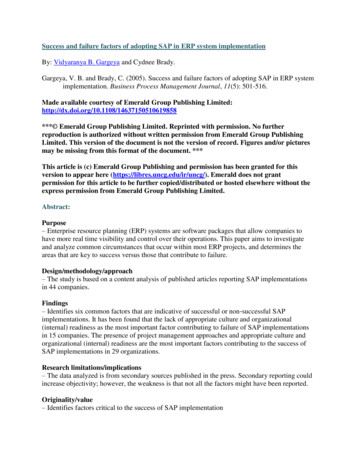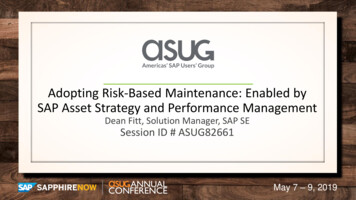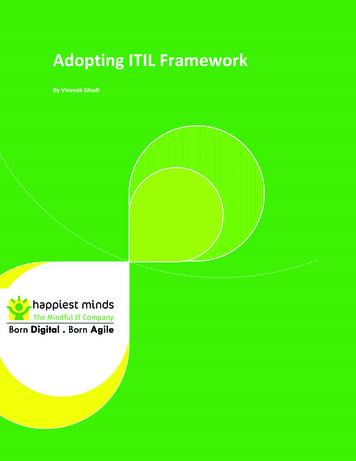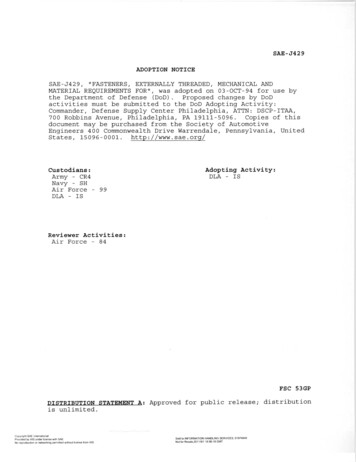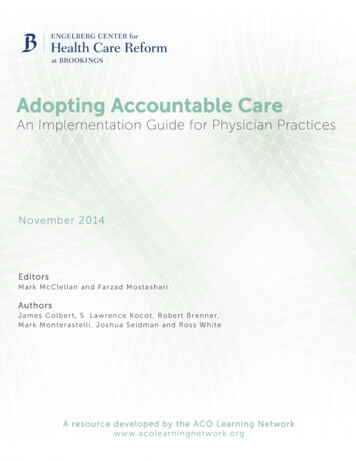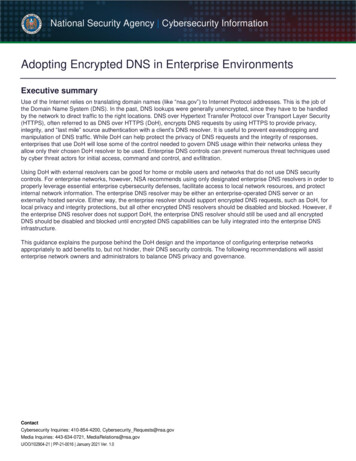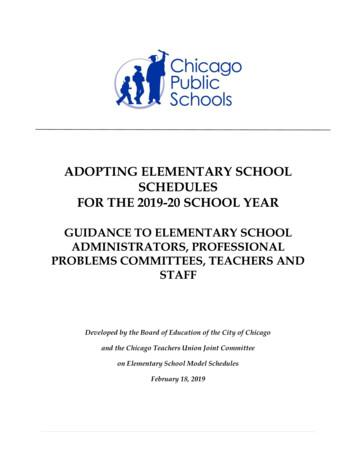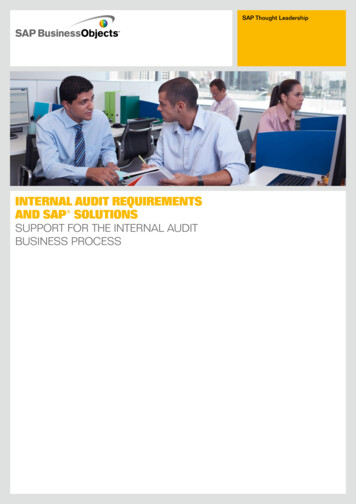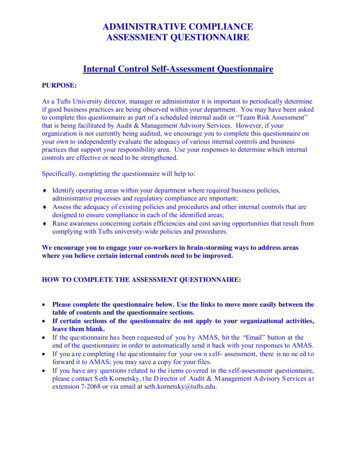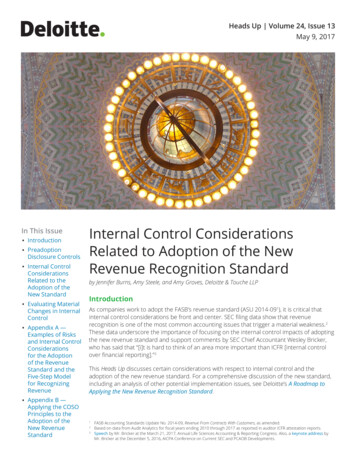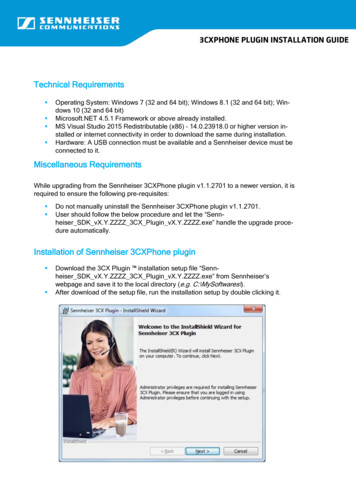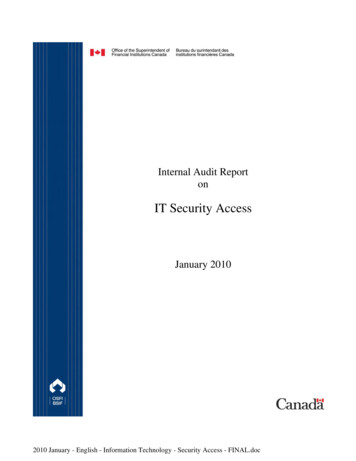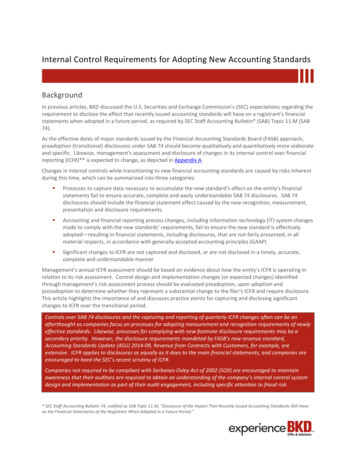
Transcription
Internal Control Requirements for Adopting New Accounting StandardsBackgroundIn previous articles, BKD discussed the U.S. Securities and Exchange Commission’s (SEC) expectations regarding therequirement to disclose the effect that recently issued accounting standards will have on a registrant’s financialstatements when adopted in a future period, as required by SEC Staff Accounting Bulletin* (SAB) Topic 11.M (SAB74).As the effective dates of major standards issued by the Financial Accounting Standards Board (FASB) approach,preadoption (transitional) disclosures under SAB 74 should become qualitatively and quantitatively more elaborateand specific. Likewise, management’s assessment and disclosure of changes in its internal control over financialreporting (ICFR)** is expected to change, as depicted in Appendix A.Changes in internal controls while transitioning to new financial accounting standards are caused by risks inherentduring this time, which can be summarized into three categories: Processes to capture data necessary to accumulate the new standard’s effect on the entity’s financialstatements fail to ensure accurate, complete and easily understandable SAB 74 disclosures. SAB 74disclosures should include the financial statement effect caused by the new recognition, measurement,presentation and disclosure requirements Accounting and financial reporting process changes, including information technology (IT) system changesmade to comply with the new standards’ requirements, fail to ensure the new standard is effectivelyadopted—resulting in financial statements, including disclosures, that are not fairly presented, in allmaterial respects, in accordance with generally accepted accounting principles (GAAP) Significant changes to ICFR are not captured and disclosed, or are not disclosed in a timely, accurate,complete and understandable mannerManagement’s annual ICFR assessment should be based on evidence about how the entity’s ICFR is operating inrelation to its risk assessment. Control design and implementation changes (or expected changes) identifiedthrough management’s risk assessment process should be evaluated preadoption, upon adoption andpostadoption to determine whether they represent a substantial change to the filer’s ICFR and require disclosure.This article highlights the importance of and discusses practice points for capturing and disclosing significantchanges to ICFR over the transitional period.Controls over SAB 74 disclosures and the capturing and reporting of quarterly ICFR changes often can be anafterthought as companies focus on processes for adopting measurement and recognition requirements of newlyeffective standards. Likewise, processes for complying with new footnote disclosure requirements may be asecondary priority. However, the disclosure requirements mandated by FASB’s new revenue standard,Accounting Standards Update (ASU) 2014-09, Revenue from Contracts with Customers, for example, areextensive. ICFR applies to disclosures as equally as it does to the main financial statements, and companies areencouraged to heed the SEC’s recent scrutiny of ICFR.Companies not required to be compliant with Sarbanes-Oxley Act of 2002 (SOX) are encouraged to maintainawareness that their auditors are required to obtain an understanding of the company’s internal control systemdesign and implementation as part of their audit engagement, including specific attention to fraud risk.* SEC Staff Accounting Bulletin 74, codified as SAB Topic 11.M, “Disclosure of the Impact That Recently Issued Accounting Standards Will Haveon the Financial Statements of the Registrant When Adopted in a Future Period.”
Internal Control Requirements for Adopting New Accounting Standards** Management is required to evaluate and assess ICFR under Section 13(a) or 15(d) of the Securities Exchange Act of 1934, an implementationof Section 404 of SOX.The rules the SEC adopted in June 2003 to implement Section 404 require management to annually evaluate the effectiveness of its ICFR and todisclose its assessment to investors. SEC Final Rule No. 33-8238, Management’s Report on Internal Control Over Financial Reporting andCertification of Disclosure in Exchange Act Periodic Reports, requires disclosure of significant changes to an entity’s ICFR. Item 308(c) ofRegulation S-K requires filers to disclose material changes to ICFR.SAB 74 & ICFR Disclosure ControlsOverview of SAB 74 DisclosuresIn addition to disclosing the expected financial statement effect of recently issued standards (when the standardwill be adopted in a future period), SEC filers are required to disclose in the notes to the financial statements: The status of the implementation process, including the nature of significant implementation matters thathave not been addressed The transition method elected (full or modified retrospective), including practical expedients A comparison of the company’s current accounting policies with the accounting policy under the newstandardIf a company does not know the expected effect, or cannot reasonably estimate, this fact should be disclosed. Inthose cases, the quantitative disclosure of the new standard’s effect should be replaced with a qualitativedescription of the new accounting policies’ effect and a comparison of the new accounting requirements to thecompany’s current accounting.ICFR Includes SAB 74 DisclosuresManagement’s ICFR assessment includes controls designed to help ensure that financial statements, including thefootnotes, are prepared in accordance with GAAP. Because transitional disclosures required under SAB 74 are partof the notes to the financial statements, controls around them are included in the ICFR annual assessment in yearsprior to adopting a newly issued standard. Management is required to disclose in the entity’s quarterly ExchangeAct reports changes in internal controls that have or will materially affect the issuer’s ICFR. In doing so, it shouldconsider “short-term” circumstances and risks uniquely present during the adoption period. Significant newcontrols may include controls to ensure accurate, complete and understandable SAB 74 disclosures and controls toaddress risks associated with process changes to develop and support significant judgments and estimates, forexample, which will be necessary to recognize revenue and provide the required ASU 2014-09 disclosures.Management would evaluate the risk that process changes will result in inaccurate and unreliable financialreporting in the current reporting period (and future reporting periods).Henceforth, capturing significant changes to ICFR (and ensuring appropriate disclosure of these changes) requiresprocesses and controls of its own—generally including oversight by knowledgeable personnel with appropriateauthority, e.g., senior management, internal audit and disclosure committee.Judgments required to identify newly required processes and controls often will require a careful evaluation ofthe detailed information regarding the nature, design and economic substance of contracts and changes thereto.Applying the new concepts, particularly for companies with complex contracts or reporting revenue from morethan one revenue stream, may require more resources and collaborative effort across the company thanoriginally planned.2
Internal Control Requirements for Adopting New Accounting StandardsPractice Points: Revenue recognition is one of the most common issues triggering an ICFR material weakness, primarilydue to accounting and financial reporting complexity and subjectivity and the elevated risk of financialstatement fraud and management override. For issuer entities subject to an assessment and reporting onICFR, documentation of the design, implementation and operating effectiveness of ICFR controls should beconsidered as important as accurately understanding the standard’s new measurement, recognition,presentation and disclosure requirements. With subjective-based standards such as the new revenue recognition standard, the risk of materialmisstatements inherently increases with the increased use of significant judgments, critical accountingestimates and assumptions. Subjective accounting and financial reporting characteristics generally resultin a systemic effect on the entity’s entire internal control system. An entity using the Committee ofSponsoring Organization’s (COSO) 2013 Internal Control – Integrated Framework, for example, willevaluate changes required to all five COSO components—control environment, e.g., tone at the top,monitoring, risk assessment and information and communication—in addition to control activities. Filers frequently avoid process changes in the last quarter of the reporting period. Ongoingimplementation team meetings with members of accounting, financial reporting and ICFR oversight can bean effective way to share the new standard’s effect on each department and ensure timely disclosure ofmaterial changes to ICFR. Controls over an entity’s disclosures extend to information contained in management’s discussion andanalysis (MD&A), e.g., controls to address the risk that MD&A information is misleading or confusing. Forthe new revenue recognition standard, for example, an entity will assess the standard’s effect on nonGAAP disclosures, key operating metrics, performance indicators and forecasts—many of which areaffected by GAAP-based revenue—and update its disclosure controls accordingly. Although not part of theICFR assessment, an entity may benefit from performing the SEC disclosure control assessment madeconcurrently with it. Refer to BKD’s article, Non-GAAP Financial Measures, for non-GAAP financialreporting insights.Next StepsBKD will continue to stay abreast of implementation best practices regarding the new revenue recognitionstandard and provide practical insights. For further information, contact your BKD advisor.ContributorConnie L. Spinelli, CPAAdditional Resources:SEC Staff Expectation on Disclosing the Impact of Upcoming Accounting StandardsRevenue Recognition: SAB 74 Disclosures3
Internal Control Requirements for Adopting New Accounting StandardsAppendix AInternal control systems are expected to change as the entity’s revenue recognition transactions are reworked tocapture the required information, particularly for companies with diverse contracts and multiple revenue streams.PreadoptionDisclosure of the new standard'seffect on future financialstatements (SAB 74)Disclosure of significant ICFRmodifications associated withimplementation activitiesCloser to AdoptionMore quanitative disclosures,when possible, of the newstandard's effect on futurefinancial statements (SAB 74)Disclosure of significant ICFRmodifications associated withprocess and IT system changesrelated to accounting andfinancial reporting under thenew standardYear of AdoptionAdoption disclosures anddisclosures required by the newstandard (ASU 2014-09)Disclosure of significant ICFRmodifications associated withaccounting policy and procedurechanges and IT system changesrelated to accounting andfinancial reporting under thenew standardICFR ControlsThe following is a noninclusive listing of risks a company may consider at each phase as it develops andimplements transitional and ongoing disclosure controls: Risks to accurate and complete application and implementation of the five-step model for recognizingrevenue. Controls addressing implementation risk generally will include monitoring of the adoptionprocess, oversight over implementing a new IT system to record revenue, controls over transition journalentries and controls over adjustments to financial statements for prior years presented, e.g., the risk that:oAll material revenue streams and contract types are not identified, e.g., whether the entity is aprincipal or an agent, licensing revenueoAccounting conclusions are not accurate – contract costs, presentation of contract assets andliabilities, presentation of revenue gross of net (principal versus agent)oInitial recording at adoption is not accurateoIT systems are not capturing the right information, or IT-generated reports used for journalentries and accounting estimates, assumptions, etc., are invalid and not monitored for dataqualityoChanges to customer contracts are not captured4
Internal Control Requirements for Adopting New Accounting Standards Risks to accurate, complete and understandable disclosures required by ASU 2014-09 and disclosure ofthe accounting changes at adoption, e.g., the disclosure controls address the risk that:oThe financial reporting function does not have in place a sustainable process for the IT system tocapture the right informationoIT-generated reports used as source documents to prepare disclosures are not adequately testedto ensure validityoDisclosures do not include significant judgments the company made when applying the guidanceoDisclosure do not allow an investor to understand the revenue arrangement and the entity’s rolein it. This is particularly pertinent in revenue versus agent assessments because a company isexpected to disclose the pertinent facts related to these judgmentsBKD’s previous article, Revenue Recognition: New Disclosures, provides insight into the extensive new disclosurerequirements of ASU 2014-09. Most notable are the qualitative and quantitative disclosures around revenuedisaggregation; contract assets, contract liabilities and receivables; and for public business entities, remainingperformance obligations. These disclosures are in addition to a description of significant judgments made—particularly around satisfaction of performance obligations—and a description of the methods, inputs andassumptions used for determining transaction price, including variable consideration and measuring returns andsimilar obligations.5
SAB 74 & ICFR Disclosure Controls . Overview of SAB 74 Disclosures . In addition to disclosing the expected financial statement effect of recently issued standards (when the standard will be adopted in a future period), SEC filers are requi
